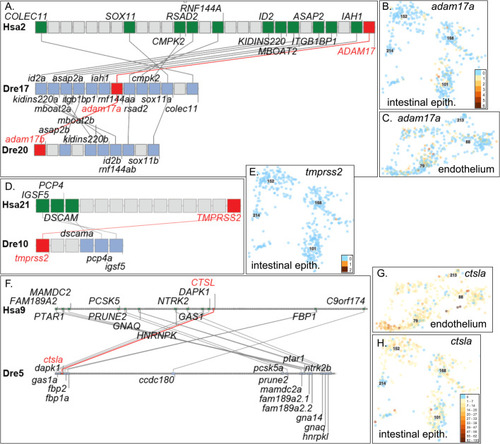- Title
-
The SARS-CoV-2 receptor and other key components of the Renin-Angiotensin-Aldosterone System related to COVID-19 are expressed in enterocytes in larval zebrafish
- Authors
- Postlethwait, J.H., Massaquoi, M.S., Farnsworth, D.R., Yan, Y.L., Guillemin, K., Miller, A.C.
- Source
- Full text @ Biol. Open
|
(A) The section of H. sapiens chromosome 1 (Hsa1) that contains AGT is conserved with the segment of D. rerio chromosome 13 (Dre13) that contains agt. (B) The 220 clusters from the zebrafish scRNA-seq Atlas (Farnsworth et al., 2020). Boxes indicate the liver, vascular endothelium, and intestinal epithelium clusters. (C) Cells in hepatocyte clusters c217, c121, and c121 express agt. Each dot represents a cell. Color intensity indicates expression level according to the scale at the right [the number of Unique Molecular Identifiers (UMIs; unique reads) in each individual cell that mapped to the gene of interest]. Blue cells are not expressing. (D) Expression of the Agt-regulator cebpb in larval liver cells. |
|
|
|
|
|
|
|
|
|
(A) Double conserved synteny between Dre17 and Dre20 confirming co-orthology of adam17a and adam17b to ADAM17 and their origin in the TGD. (B) Expression of adam17a in intestinal epithelium and (C) vascular endothelium. (D) Conserved syntenies verify orthology of tmprss2 to TMPRSS2. (E) Expression of tmprss2 was detected in one cell in intestinal epithelium c168 and in only 12 other cells broadly dispersed in the atlas. (F) Human CTSL shares conserved syntenies with zebrafish ctsla. (G) Expression of ctsla in the endothelium and (H) intestinal epithelium. |
|
|
|
|








